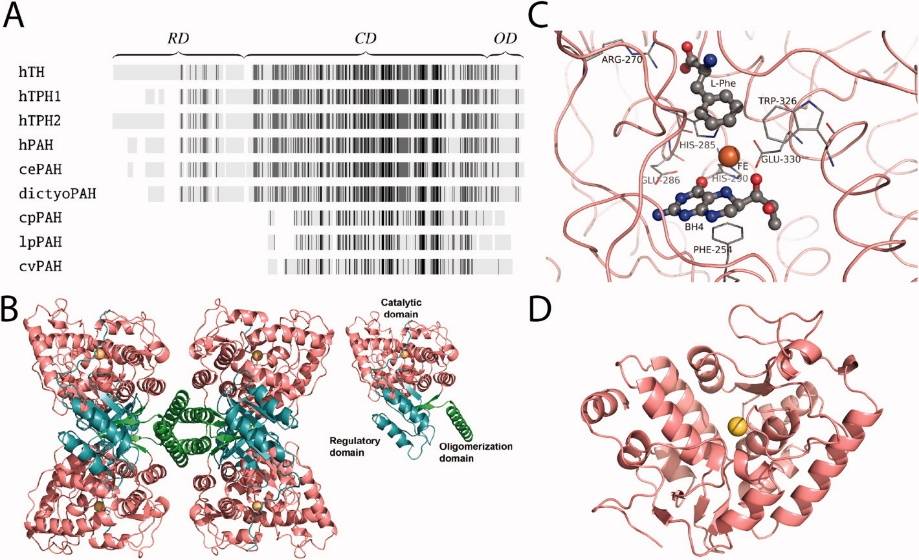What is PAH Protein
Phenylalanine Hydroxylase (PAH), often referred to as PheOHase, is a crucial enzyme responsible for catalyzing the conversion of phenylalanine to tyrosine in the human body. This process is fundamental for maintaining balanced levels of amino acids, which play a pivotal role in various biological functions.
PAH Protein Structural Characteristics and Classification
PAH belongs to the family of aromatic amino acid hydroxylases, which includes tyrosine hydroxylase and tryptophan hydroxylase. Structurally, PAH is characterized by a tetrameric conformation, with each monomer containing iron and a cofactor called tetrahydrobiopterin (BH4). The structural intricacies of PAH are crucial for its catalytic activity and are a subject of ongoing research.

Figure 1. Domain organization and structure of PAH. (Flydal M I, et al., 2013)
Recent Research Advances about PAH Protein
Recent research has shed light on the classification of PAH variants, emphasizing their impact on enzyme activity and phenylalanine metabolism. Understanding the genetic variations in PAH has become essential for personalized medicine, especially in the context of phenylketonuria (PKU) and other related disorders.
PAH Biological Functions and Molecular Mechanisms
The primary function of PAH is to regulate phenylalanine levels in the body by converting it into tyrosine. Tyrosine is a precursor for neurotransmitters, such as dopamine and norepinephrine, and plays a vital role in the synthesis of melanin and thyroid hormones. PAH's enzymatic activity is a linchpin in maintaining the delicate balance of these essential molecules.
PAH achieves its catalytic function through a multistep process involving the binding of phenylalanine and BH4 to the enzyme's active site. This interaction facilitates the hydroxylation of phenylalanine, ultimately leading to the production of tyrosine. Disruptions in this molecular dance, whether due to genetic mutations or environmental factors, can result in the accumulation of phenylalanine, contributing to various health issues.
PAH Related Signaling Pathway
The signal pathway associated with PAH revolves around the delicate balance between phenylalanine and tyrosine levels. The dysregulation of this pathway can trigger a cascade of events, affecting neurotransmitter synthesis, melanin production, and thyroid function. Understanding the intricacies of this signaling pathway is critical for developing targeted interventions and therapies for PAH-related disorders.
PAH Related Diseases
PAH-related diseases primarily revolve around the malfunction or deficiency of the PAH enzyme, leading to disorders like phenylketonuria (PKU). PKU is an inherited metabolic disorder characterized by the inability to metabolize phenylalanine, resulting in its toxic buildup in the body. If left untreated, PKU can lead to intellectual disabilities and other neurological complications.
PAH's Applications in Biomedicine
- Diagnostic Development: PAH has emerged as a valuable tool in diagnostic development, particularly in screening for genetic mutations associated with PKU. Advanced molecular techniques enable the identification of specific PAH variants, allowing for early detection and intervention to mitigate the adverse effects of PKU.
- Vaccine Development: The structural characteristics of PAH make it an attractive candidate for vaccine development. Research is underway to harness the immunogenic properties of PAH for designing vaccines against infectious diseases. This innovative approach holds promise for creating vaccines that induce a robust immune response.
- Therapeutics: Exploring the therapeutic potential of PAH extends beyond PKU management. Researchers are investigating the modulation of PAH activity as a potential strategy for treating conditions associated with neurotransmitter imbalances, such as certain psychiatric disorders. Targeting PAH opens new avenues for precision medicine and novel therapeutic interventions.
Recommended Products
| Cat.# | Product name | Species | Source (Host) | Tag |
|---|---|---|---|---|
| PAH-28935TH | Recombinant Human PAH | Human | N/A | |
| PAH-1510H | Recombinant Human PAH, His-tagged | Human | E.coli | His |
| PAH-259H | Recombinant Human PAH Protein, MYC/DDK-tagged | Human | HEK293 | Myc/DDK |
| PAH-466H | Recombinant Human PAH protein, His-tagged | Human | Insect Cells | His |
| PAH-469H | Recombinant Human PAH, GST-tagged | Human | Wheat Germ | GST |
| PAH-467H | Recombinant Human PAH(415 Asn/Asp), His-tagged | Human | Insect Cells | His |
| PAH-260H | Recombinant Human PAH Protein, His-tagged | Human | HEK293 | His |
| PAH-1318H | Recombinant Human PAH Protein, His-SUMO-tagged | Human | E.coli | His/SUMO |
| PAH-16HFL | Recombinant Full Length Human PAH Protein, C-Flag-tagged | Human | Mammalian cells | Flag |
| PAH-199H | Recombinant Human PAH Protein, MYC/DDK-tagged, C13 and N15-labeled | Human | HEK293 | C-Myc/DDK |
Reference
- Flydal M I, Martinez A. Phenylalanine hydroxylase: function, structure, and regulatio. IUBMB life. 2013, 65(4): 341-349.

